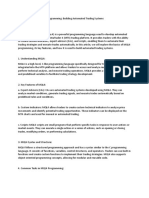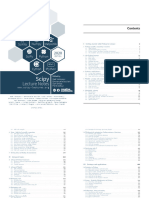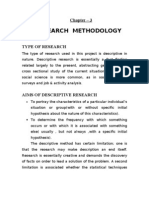Stocks Data Analysis and Visualization Using Python Assignment
Uploaded by
bug myweeksStocks Data Analysis and Visualization Using Python Assignment
Uploaded by
bug myweeksStocks Data Analysis and Visualization Solution Using Python
Problem Statement:
For Investors to properly manage their portfolios, they need to visualize datasets, find
useful patterns and gain valuable insights such as stock daily returns and risks.
In this project we will use the power of python to perform stock data visualization and
stock return calculation.
Dataset:
Link: https://drive.google.com/file/d/1VX2IO8FVaFgv7dCPzH-
7WxSLHhxwkbK8/view?usp=sharing
The Dataset contains stock prices of certain companies listed in S&P 500. S&P 500 is
a stock market index that measures the stock performance of 500 large companies
listed on U.S. stock exchange.
Check the list of S&P 500 companies here:
https://en.wikipedia.org/wiki/List_of_S%26P_500_companies
Below is the list of stocks considered:
AAPL = Apple Stock
BA = Boeing
T = AT&T
MGM = MGM Resorts International (Hotel Industry)
AMZN = Amazon
IBM = IBM
TSLA = Tesla Motors
GOOG = Google
Questions:
1) How do you read the data from stock.csv file using pandas module.
2) Print out the number of stocks.
3) Print the name of stocks.(Try using for loop)
4) What is the average return of the S&P500?
5) Which stock or index has the minimum dispertion from the mean in dollar
value?
6) What is the maximum price for AMZN stock over the specified time
period?
7) Check if data contains any null values.
8) Get dataframe information.
9) Define a function to plot RAW STOCK PRICES (WITHOUT
NORMALIZATION/WITHOUT SCALING).
# The function takes in a Dataframe df as an input argument and does not
return anything back!
# The function performs data visualization.
# Pandas works great with matplotlib, you can simply plot data directly from a
Pandas DataFrame using plot() method(Take Date on X – axis).
10) Plot Normalized/Scaled stock prices.
# To plot Normalized/Sclaed stock prices means to start all of the stock prices
at one point so that they can be easily compared.This will help you to see the
amount of gains you are going to get from the listed companies.
# Create a Function that takes in Dataframe and returns Normalized Dataframe.
# For Normalization take the stock prices and divide them by the value in the
first row of dataframe.( Notice the massive gains in Tesla Stock)
11) Perform Interactive Data visualization using Plotly.
Ref: https://plotly.com/python/
Ref: https://plotly.com/python/line-charts/
# Write a Function to perform an interactive data plotting of RAW STOCK
PRICES (WITHOUT NORMALIZATION/WITHOUT SCALING) using
plotly express.
# Plotly.express module which is imported as px includes functions that can
plot interactive plots easily and effectively.
# Loop through each stock (while ignoring time columns with index 0)
# add a new Scatter trace.(hint:fig.add_scatter)
12) SimilarlyPlot normalized stock data in an interactive way.
13) It seems that most stocks experienced massive drops in 2020, let's assume
that you own 100 shares of the S&P500 and you bought them on Feb 19th,
2020. How much did you lose (in $) by March 23rd, 2020? Hint: S&P500
dropped from $3386.15 on Feb 19th, 2020 to $2237.4 by March 23rd, 2020.
14) Calculate the daily return for S&P 500.
# get sp500 data from the dataframe.
#l loop through every element in the data frame.
# Calculate the percentage of change from the previous day.
Hint: df_daily_return[j] = ((df[j]- df[j-1])/df[j-1]) * 100
# put zero in the first line item
15) Calculate the daily return for Amazon stock.
16) Define a function to calculate stocks daily returns (for all stocks)
# With in the function Loop through each stock (while ignoring time columns
with index 0)
# Loop through each row belonging to the stock
# Calculate the percentage of change from the previous day
Hint: df_daily_return[i][j] = ((df[i][j]- df[i][j-1])/df[i][j-1]) * 100
# Set the value of first row to zero since the previous value is not available
# Use the function to get Daily returns of all the stocks.
17) Plot the Daily returns vs. time graph using both static and interactive
plots.
Hint: use function obtianed in question 10 and question 11.
18) Calculate correlation between Daily returns of all stocks.
# Drop Date column.
# Use .corr() function
# Use heat map to show correlation.
19) From the heatmap obtained ans the following questions.
# What are the top 2 stocks that are positively correlated with the S&P500?
#What is the correlation between Amazon and Boeing? Comment on your
answer
# What is the correlation between MGM and Boeing? Comment on your
answer
20) Plot Histogram for Daily returns.
21) Based on the histogram, which of the following stocks are more risky? T or
TSLA
You might also like
- Dan Stefanica, Radoš Radoičić, Tai-Ho Wang - 150 Most Frequently Asked Questions on Quant Interviews, Third Edition (Pocket Book Guides for Quant Interviews)-FE Press, LLC (2024)No ratings yetDan Stefanica, Radoš Radoičić, Tai-Ho Wang - 150 Most Frequently Asked Questions on Quant Interviews, Third Edition (Pocket Book Guides for Quant Interviews)-FE Press, LLC (2024)280 pages
- Uniswap v3 Core: March 2021 Hayden Adams Noah Zinsmeister Moody SalemNo ratings yetUniswap v3 Core: March 2021 Hayden Adams Noah Zinsmeister Moody Salem9 pages
- CS5228 Project 2 Twitter Sentiment Analysis Group No.: 29: 1 Problem StatementNo ratings yetCS5228 Project 2 Twitter Sentiment Analysis Group No.: 29: 1 Problem Statement15 pages
- Introduction To Quant Investing With Python - by Luís Fernando Torres - InsiderFinance WireNo ratings yetIntroduction To Quant Investing With Python - by Luís Fernando Torres - InsiderFinance Wire21 pages
- Portfolio Composition and Backtesting: Dakota WixomNo ratings yetPortfolio Composition and Backtesting: Dakota Wixom34 pages
- Implementing Time Series Stock Price Prediction With LSTM and Yfinance in Python - by SR - MediumNo ratings yetImplementing Time Series Stock Price Prediction With LSTM and Yfinance in Python - by SR - Medium14 pages
- Learn Python For Finance & Accounting A Comprehensive and Step by Step Guide To Unleashe Your Career PotentialNo ratings yetLearn Python For Finance & Accounting A Comprehensive and Step by Step Guide To Unleashe Your Career Potential364 pages
- Python Will Make You Rich in The Stock MarketNo ratings yetPython Will Make You Rich in The Stock Market8 pages
- Download full Machine Learning in Finance: From Theory to Practice Matthew F. Dixon ebook all chapters86% (7)Download full Machine Learning in Finance: From Theory to Practice Matthew F. Dixon ebook all chapters65 pages
- OceanofPDF.com Machine Learning for Beginners Complete a - Declan MellorNo ratings yetOceanofPDF.com Machine Learning for Beginners Complete a - Declan Mellor102 pages
- A Python Book Beginning Python Advanced Python and Python ExercisesNo ratings yetA Python Book Beginning Python Advanced Python and Python Exercises261 pages
- Get Serverless Development on AWS: Building Enterprise-Scale Serverless Solutions 1st Edition Sheen Brisals PDF ebook with Full Chapters Now100% (3)Get Serverless Development on AWS: Building Enterprise-Scale Serverless Solutions 1st Edition Sheen Brisals PDF ebook with Full Chapters Now26 pages
- Machine Learning For Asset Management by Emmanuel Jurczenko Part 010% (1)Machine Learning For Asset Management by Emmanuel Jurczenko Part 0130 pages
- Secrets of Millionaire Investors PDF FreeNo ratings yetSecrets of Millionaire Investors PDF Free272 pages
- Delgado - Forex: The Fundamental Analysis.No ratings yetDelgado - Forex: The Fundamental Analysis.10 pages
- Good Housing Leads To Good Health: A Toolkit For Environmental Health PractitionersNo ratings yetGood Housing Leads To Good Health: A Toolkit For Environmental Health Practitioners44 pages
- Efficient MySQL Performance (Final Release) 1st Edition Daniel Nichter download pdf100% (3)Efficient MySQL Performance (Final Release) 1st Edition Daniel Nichter download pdf65 pages
- Igor Tulchinsky'S Worldquant Is Part of The Forefront of A New Quantitative Renaissance in InvestingNo ratings yetIgor Tulchinsky'S Worldquant Is Part of The Forefront of A New Quantitative Renaissance in Investing2 pages
- 20道資料視覺化難題全解析:提案、簡報、圖表、讓數據說話、35個案例現學現套用,將訊息植入對方心智,讓大家都聽你的!No ratings yet20道資料視覺化難題全解析:提案、簡報、圖表、讓數據說話、35個案例現學現套用,將訊息植入對方心智,讓大家都聽你的!304 pages
- Quantitative Option Strategies: Marco Avellaneda G63.2936.001 Spring Semester 2009No ratings yetQuantitative Option Strategies: Marco Avellaneda G63.2936.001 Spring Semester 200929 pages
- A Noise Tolerant Money Management Stop System Trader SuccessNo ratings yetA Noise Tolerant Money Management Stop System Trader Success6 pages
- Scikit-Learn: Library For Machine Learning and Data Science With PythonNo ratings yetScikit-Learn: Library For Machine Learning and Data Science With Python11 pages
- Matlab-STATISTICAL MODELS AND METHODS FOR FINANCIAL MARKETSNo ratings yetMatlab-STATISTICAL MODELS AND METHODS FOR FINANCIAL MARKETS13 pages
- TOP 7 Python Libraries For DATA Visualization!!No ratings yetTOP 7 Python Libraries For DATA Visualization!!9 pages
- Approaching (Almost) Any Machine Learning Problem100% (1)Approaching (Almost) Any Machine Learning Problem300 pages
- Full Download SQL in 10 Minutes A Day, Sams Teach Yourself 5th Edition Ben Forta PDF100% (3)Full Download SQL in 10 Minutes A Day, Sams Teach Yourself 5th Edition Ben Forta PDF41 pages
- Investor Sentiment and The Max Effect - Wai Mun Fong Benjamin TohNo ratings yetInvestor Sentiment and The Max Effect - Wai Mun Fong Benjamin Toh12 pages
- Salesforce Certified Platform Developer I CRT-450 Exam PreparationFrom EverandSalesforce Certified Platform Developer I CRT-450 Exam PreparationNo ratings yet
- Advanced C++ Interview Questions You'll Most Likely Be AskedFrom EverandAdvanced C++ Interview Questions You'll Most Likely Be AskedNo ratings yet
- Implementation of TPM: Dr. Siti Rosimah, ST., MT., IPU Minggu Ke-2No ratings yetImplementation of TPM: Dr. Siti Rosimah, ST., MT., IPU Minggu Ke-232 pages
- Hotpoint-Ariston WMG 823 EU Washing MachineNo ratings yetHotpoint-Ariston WMG 823 EU Washing Machine48 pages
- Signalling Solutions Harmony XVC/R/S: Catalogue NovemberNo ratings yetSignalling Solutions Harmony XVC/R/S: Catalogue November21 pages
- Electrical License Examination Guide: 20210211 - Licensingexaminationguide Checked 20210211No ratings yetElectrical License Examination Guide: 20210211 - Licensingexaminationguide Checked 2021021133 pages
- Module 3 - Software Development and DesignNo ratings yetModule 3 - Software Development and Design83 pages
- NQM 11 Specialist Maths 02 Methods of ProofNo ratings yetNQM 11 Specialist Maths 02 Methods of Proof36 pages
- Chapter 3: Information Theory: Section 3.5No ratings yetChapter 3: Information Theory: Section 3.522 pages
- Nonlinear Dynamics and Chaos: Bruce E KendallNo ratings yetNonlinear Dynamics and Chaos: Bruce E Kendall8 pages
- Homosexuality and The Christian A Guide For Parents, Pastors, and100% (1)Homosexuality and The Christian A Guide For Parents, Pastors, and200 pages
- Design and Delivery of Tactical Decision Games: PMS 468-1 AUGUST 2018No ratings yetDesign and Delivery of Tactical Decision Games: PMS 468-1 AUGUST 201840 pages

























































































